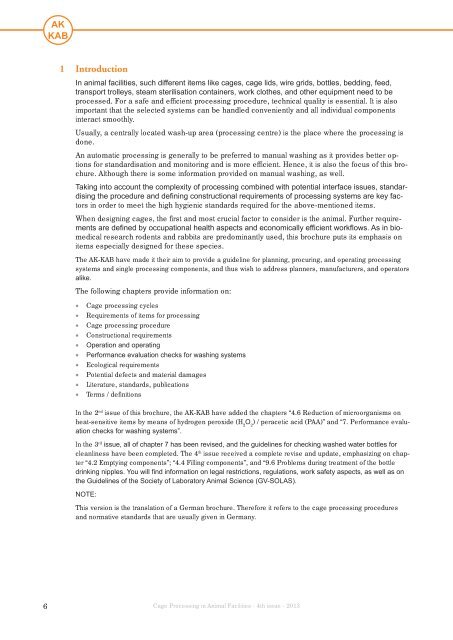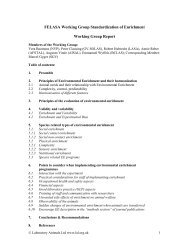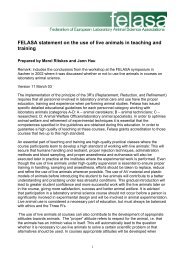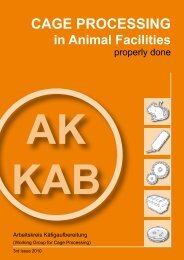CAGE PROCESSING in Animal Facilities - Felasa
CAGE PROCESSING in Animal Facilities - Felasa
CAGE PROCESSING in Animal Facilities - Felasa
- No tags were found...
Create successful ePaper yourself
Turn your PDF publications into a flip-book with our unique Google optimized e-Paper software.
1 IntroductionIn animal facilities, such different items like cages, cage lids, wire grids, bottles, bedd<strong>in</strong>g, feed,transport trolleys, steam sterilisation conta<strong>in</strong>ers, work clothes, and other equipment need to beprocessed. For a safe and efficient process<strong>in</strong>g procedure, technical quality is essential. It is alsoimportant that the selected systems can be handled conveniently and all <strong>in</strong>dividual components<strong>in</strong>teract smoothly.Usually, a centrally located wash-up area (process<strong>in</strong>g centre) is the place where the process<strong>in</strong>g isdone.An automatic process<strong>in</strong>g is generally to be preferred to manual wash<strong>in</strong>g as it provides better optionsfor standardisation and monitor<strong>in</strong>g and is more efficient. Hence, it is also the focus of this brochure.Although there is some <strong>in</strong>formation provided on manual wash<strong>in</strong>g, as well.Tak<strong>in</strong>g <strong>in</strong>to account the complexity of process<strong>in</strong>g comb<strong>in</strong>ed with potential <strong>in</strong>terface issues, standardis<strong>in</strong>gthe procedure and def<strong>in</strong><strong>in</strong>g constructional requirements of process<strong>in</strong>g systems are key factors<strong>in</strong> order to meet the high hygienic standards required for the above-mentioned items.When design<strong>in</strong>g cages, the first and most crucial factor to consider is the animal. Further requirementsare def<strong>in</strong>ed by occupational health aspects and economically efficient workflows. As <strong>in</strong> biomedicalresearch rodents and rabbits are predom<strong>in</strong>antly used, this brochure puts its emphasis onitems especially designed for these species.The AK-KAB have made it their aim to provide a guidel<strong>in</strong>e for plann<strong>in</strong>g, procur<strong>in</strong>g, and operat<strong>in</strong>g process<strong>in</strong>gsystems and s<strong>in</strong>gle process<strong>in</strong>g components, and thus wish to address planners, manufacturers, and operatorsalike.The follow<strong>in</strong>g chapters provide <strong>in</strong>formation on:• Cage process<strong>in</strong>g cycles• Requirements of items for process<strong>in</strong>g• Cage process<strong>in</strong>g procedure• Constructional requirements• Operation and operat<strong>in</strong>g• Performance evaluation checks for wash<strong>in</strong>g systems• Ecological requirements• Potential defects and material damages• Literature, standards, publications• Terms / def<strong>in</strong>itionsIn the 2 nd issue of this brochure, the AK-KAB have added the chapters “4.6 Reduction of microorganisms onheat-sensitive items by means of hydrogen peroxide (H 2O 2) / peracetic acid (PAA)” and “7. Performance evaluationchecks for wash<strong>in</strong>g systems”.In the 3 rd issue, all of chapter 7 has been revised, and the guidel<strong>in</strong>es for check<strong>in</strong>g washed water bottles forcleanl<strong>in</strong>ess have been completed. The 4 th issue received a complete revise and update, emphasiz<strong>in</strong>g on chapter“4.2 Empty<strong>in</strong>g components”; “4.4 Fill<strong>in</strong>g components”, and “9.6 Problems dur<strong>in</strong>g treatment of the bottledr<strong>in</strong>k<strong>in</strong>g nipples. You will f<strong>in</strong>d <strong>in</strong>formation on legal restrictions, regulations, work safety aspects, as well as onthe Guidel<strong>in</strong>es of the Society of Laboratory <strong>Animal</strong> Science (GV-SOLAS).NOTE:This version is the translation of a German brochure. Therefore it refers to the cage process<strong>in</strong>g proceduresand normative standards that are usually given <strong>in</strong> Germany.6Cage Process<strong>in</strong>g <strong>in</strong> <strong>Animal</strong> <strong>Facilities</strong> · 4th issue · 2013






